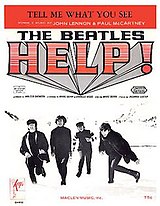Tell Me What You See
| "Tell Me What You See" | |
|---|---|
 Cover of the song's sheet music | |
| Song by the Beatles | |
| from the album Help! | |
| Released | 6 August 1965 |
| Recorded | 18 February 1965 |
| Studio | EMI, London |
| Genre | Rock |
| Length | 2:36 |
| Label | Parlophone |
| Songwriter(s) | Lennon–McCartney |
| Producer(s) | George Martin |
"Tell Me What You See" is a song by the English rock band the Beatles that first appeared in 1965 on their album Help! in the United Kingdom and on Beatles VI in the United States. As with all Beatles compositions by either of the two, the song is credited to Lennon–McCartney. Regarding the song's authorship, Paul McCartney said, "I seem to remember it as mine. I would claim it as a 60–40 but it might have been totally me."[1] John Lennon said, in his interviews with Playboy (1980) and Hit Parader (1972), that "Tell Me What You See" was written completely by McCartney.
Composition[]
Despite McCartney's later comments – "Not awfully memorable",[1] in an interview with author Barry Miles – "Tell Me What You See" shows the musical growth of the Beatles since Please Please Me, and foreshadows their further exploration on Rubber Soul and Revolver. Following each repetition of the title phrase, there is a brief instrumental break featuring a Hohner Pianet. The instrument is featured on two other tracks on Help!: "You Like Me Too Much" and "The Night Before", both recorded the day before "Tell Me What You See." Ringo Starr's drumming on the track is augmented with a trio of percussion instruments; a güiro, a tambourine, and a pair of claves. This is not the first time the Beatles had used additional percussion instruments to flesh out their sound, having done so as early as "Don't Bother Me" in 1963.
Evident in the song's structure and instrumentation are the Beatles' then growing folk influence, with lyrics more mature and reflective than was standard in their earlier output. The line "trying to get to you" (the title of an early Elvis Presley song recorded for Sun Records, which served as inspiration for McCartney and George Harrison's composition "In Spite of All the Danger") reflects the band's continued love of early rock and roll.[original research?] Other songs on Help!, such as Lennon's "You've Got to Hide Your Love Away" and the title track, also exhibit compositional growth.[according to whom?]
A verse in the song, beginning with the line "Big and black the clouds may be", was taken from a religious inscription that had hung in Lennon's childhood home in Liverpool: "However black the clouds may be, in time they’ll pass away. Have faith and trust and you will see, God’s light make bright your day." The same inscription was parodied by Lennon in his 1965 book A Spaniard in the Works.[2]
Personnel[]
- Paul McCartney – lead vocal,[3] bass, electric piano
- John Lennon – lead vocal,[3][4] rhythm guitar, tambourine[5]
- George Harrison – güiro[5]
- Ringo Starr – drums, claves[5]
- Personnel per Ian MacDonald[6] except where noted.
Cover versions[]
The song has been covered by other artists, including Teenage Fanclub and Jacob's Trouble.
Notes[]
- ^ Jump up to: a b Miles 1997, p. 200.
- ^ Lydon, Michael (2014) [March 1966]. "Lennon and McCartney: Songwriters – A Portrait from 1966". Rock's Backpages.
- ^ Jump up to: a b Stannard 1984, p. 33.
- ^ Publishing, D. K. (4 October 2004). The Beatles: 10 YEARS THAT SHOOK THE WORLD. DK ADULT. ISBN 0756606705.
- ^ Jump up to: a b c "Tell Me What You See". 16 March 2008. Retrieved 15 April 2018.
- ^ MacDonald 2005, p. 149.
References[]
- MacDonald, Ian (2005). Revolution in the Head: The Beatles' Records and the Sixties (Second Revised ed.). London: Pimlico (Rand). ISBN 1-84413-828-3.
- Miles, Barry (1997). Paul McCartney: Many Years From Now. New York: Henry Holt and Company. ISBN 0-8050-5249-6.
- Stannard, Neville (1984). The Beatles' The Long and Winding Road: A History of the Beatles on Record. New York: Avon Books.
External links[]
- The Beatles songs
- Song recordings produced by George Martin
- Songs written by Lennon–McCartney
- Songs published by Northern Songs
- 1965 songs
- Songs composed in G major